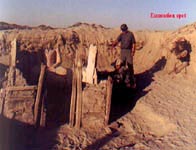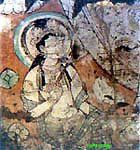 Archaeologists have discovered a temple that dates back over 1,500 years, located at the edge of the Taklimakan Desert in the northwestern region of the Xinjiang Uyghur Autonomous Region, China.
Archaeologists have discovered a temple that dates back over 1,500 years, located at the edge of the Taklimakan Desert in the northwestern region of the Xinjiang Uyghur Autonomous Region, China.
The temple, named Tuopulukedun, stands 2.25 meters tall and 2 meters wide, with surrounding walls approximately 1.3 meters high. It is constructed from wood and mud, featuring murals depicting Mahayana Buddhism on all four walls. A statue of Buddha, measuring 0.65 meters, is situated at the center of the temple, while to the north are statues of Buddha with broad shoulders and slender waists.
According to Wu Xinhua from the Chinese Archaeology Institute, this temple is currently considered the smallest temple ever discovered in the world. “It is also the only ancient temple in the Taklimakan Desert that remains relatively intact, with clearly visible murals,” Wu stated.
Approximately 3,000 years ago, the Yutian Kingdom emerged at the southern edge of the Taklimakan Desert—the largest desert in China and the second largest in the world. Buddhism was introduced to the Yutian Kingdom during that period.
The Yuchi clan, which began ruling Yutian around 2,000 years ago, held Buddhism in high esteem and endeavored to promote this faith by constructing numerous temples. This led to the spread of Mahayana Buddhism into the inland regions of China.
 |
|
A section of the wall mural |
In the mid-8th century, the Kalahan Kingdom, located to the west of the Taklimakan Desert, launched a religious war against Yutian, ultimately defeating this dynasty in 1006. Following this, Islam was introduced and gained popularity. Many temples built during the Yutian era were destroyed over the past 1,000 years.
The Tuopulukedun temple had been buried under sand for about 1,500 years and was recently discovered by a herdsman by chance. Archaeologists from the Chinese Academy of Social Sciences conducted excavations in a 100-meter radius around the temple from September 30 to October 12 this year but found no other significant remains.
The Tuopulukedun temple has opened a new avenue for archaeologists to study the ancient Yutian dynasty. The temple’s shape, structure, wall murals, and other relics are also crucial for researching Buddhism and mural art from the Yutian dynasty, as well as the development of Buddhism in northwestern China and the Chinese mainland.
The temple also serves as evidence of the East-West cultural exchange along the Silk Road, a vital trade route that connected China with Asia for over 2,000 years.
Located 500 meters west of the temple is a 30-meter-wide canal running in a north-south direction. The area along the canal was once the center of the Bimo Kingdom, a small dynasty established on an oasis, which was later occupied by the Yutian dynasty. The canal is locally known as Damagou. Wu stated that the name Damagou actually derives from Sanskrit, meaning “Reservoir of the Buddha’s Teachings.”
Archaeologists also discovered a large number of artifacts around the Damagou area, confirming the history of the Yutian dynasty and the history of southern Xinjiang.
M.T. (according to Xinhua News Agency)


















































